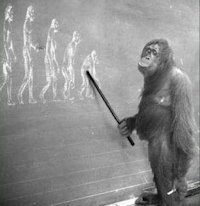
|
Some Common Myths Thought to be True - Myth 56
Myth 56: Evolution Plans to Improve an Organism's Fitness
Evolution does not "plan" to improve an organism's fitness to survive. For
example, an incorrect way to describe giraffe evolution is to say that giraffe
necks grew longer over time because they needed to reach tall trees. Evolution
does not see a need and respond; it is instead a goalless process. A mutation
resulting in longer necks would be more likely to benefit an animal in an area
with tall trees than an area with short trees, and thus enhance the chance of
the animal surviving to pass on its longer-necked genes.
|
| Theory of Evolution | |
|
The misconception is encouraged as it is common shorthand for people who
understand how evolution works to speak of a purpose as a concise form of
expression (sometimes called the "metaphor of purpose"); it is less cumbersome
to say "Dinosaurs may have evolved feathers for courtship" than "Feathers may
have been selected for when they arose as they gave dinosaurs a selective
advantage over their non-feathered peers"
|
|
| ⇦ Back to Myth 55 Return to Myth Choices Page 4 On to Myth 57 ⇨ | |